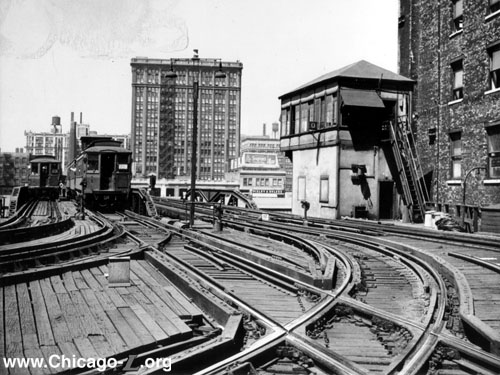
Market Junction, where the Metropolitan Division main line, connector to the Loop Elevated, and approach tracks to the Wells Street Terminal came together, is seen looking west. The Market Tower, controlling the junction and the throat to Wells Street Terminal, is on the right. For
a larger view, click here. (Photo from the CTA Collection) |
Market
Tower
Market Street between
Jackson Blvd. and Van Buren Street, Loop
Service
Notes:
|
Services:
|

|
Garfield Line
|
Quick Facts:
Established: May 6, 1895
Original Line: Metropolitan West Side Elevated Railroad
Rebuilt: n/a
Status: Demolished
Profile:
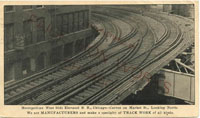
This postcard from Paige Iron Works, manufacturers of specialty trackwork, shows their work for the Met where the line curved from the bridge over the Chicago River to over Market Street on its way to the Loop, where it changed from two tracks of the Loop connector into the four tracks of the Met main line. This shot dates from the short period 1897-1904, after the Franklin Street Terminal closed but before the Fifth Avenue Terminal opened. For a larger view, click here. (Postcard courtesy of the J.J. Sedelmaier Collection) |
A tower at Market Street on the Metropolitan West Side Elevated's main line was first established in 1895 when the Met extended across the South Branch of the Chicago River into their compact and, as it turned out, short-lived Franklin Street Terminal. The Met crossed the river between Jackson and Van
Buren on a bridge of their construction and sole use. The bridge, a type called a "Scherzer Rolling Lift Bridge", consisted of separate decks on each side of the river that met in the
middle but which could roll upward at a pivot point on the shore,
guided by a track. The bridge for Met's four-track line actually
consisted of two two-track bridges side-by-side. The bridge had at least one control tower, on the west side of the river. After the tracks crossed the river, an interlocked set of switches and crossovers between the east shore of the river and Market Street controlled access in and out of the Franklin Street Terminal. The tower that controlled the interlocking was located over Market Street on the north side of the right-of-way.1
The Franklin Street Terminal was in use for just for less than three
years between 1895 and 1897. In 1897, the Loop Elevated was completed and on October 11, 1897, all Met trains were routed there. At this time, the
Franklin Street Terminal was closed and demolished. The tracks east of Market into the terminal were demolished and instead merged from four down to two tracks and curved south a half block over Market Street, then turned east over Van Buren Street to join the Loop at Tower 8.
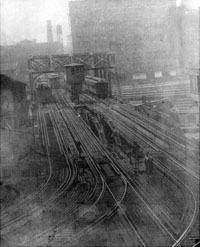
This view circa 1905 looks west toward the Scherzer Rolling Lift Bridge over the South Branch of the Chicago River and the West Shore Tower that controlled it, and four Met trains crossing the truss bridge over the Union Station south concourse beyond. Market Tower can barely be seen on the right side of the photo. For a larger view, click here. (Photo courtesy of the Krambles-Peterson Archive) |
Soon, the Loop reached operating capacity and trains were being turned back at Canal Street, west of the Chicago River.
This was by no means ideal, so the Met revived its plans for a terminal at Fifth Avenue, this time to augment the Loop as an
auxiliary terminal facility. In mid-1902, the city council granted
the Met approval to construct a four-track terminal at Fifth Avenue,
just south of Jackson Boulevard. The Fifth
Avenue Terminal opened on October 3, 1904.
At this time, a junction was established at Market Street between Jackson Boulevard and Van Buren Street where the Metropolitan main line, the Loop connector tracks, and the tracks to the new Fifth
Avenue Terminal met just east of the river. A tower, known as Market Tower, was established to control this junction as well as the switches and crossovers on the approach tracks for Fifth
Avenue Terminal. The tower was also known as "East Bank Tower"2, and Market Junction was also apparently also called as "East Shore Junction"3. This was presumably a new tower from the one that controlled the approach to the old Franklin Street Terminal from 1895 to 1897, as the new tower was located west of the first one, on the bank of the river, and the Met presumably would've removed the old tower when there was no need for it between 1897 and 1904.
There is some indiction that Market Tower could also control the Met's river bridge, acting as an auxiliary facility to the primary control location on the west side of the bridge, known variously as West Shore Tower or West Bank Tower.4 Some sources say the bridge was controlled solely from West Shore Tower.5 6 Other sources suggest there was originally an East Shore Tower, with West Shore controlling the two west bridge leaves and East Shore controlling the east leaves, but that East Shore Tower was subsequently removed and its functions transferred to Market Tower.7 The photo on the left from 1905 shows only West Shore Tower and Market Tower (barely in view on the right), meaning that if this was the case that East Shore Tower must have been removed at the same time as or within one year of Market Tower opening. It may also be possible the East Shore Tower was the tower that also controlled the switches on the approach to the old Franklin Street Terminal.
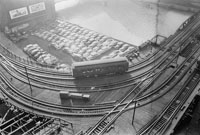
A single-car Met train turns from the Met main line onto the Loop connector in this overhead view of Market Junction in 1949. For a larger view, click here. (Photo by Stanley Kubrick) |
Operations at Market Junction became simpler in the 1950s as various services ceased coming through the junction. On February 25 1951, Logan Square trains were diverted to the new Milwaukee-Dearborn Subway, removing them from the Met main line. Effective the same date, Humboldt
Park service was reduced to a shuttle from Damen to Lawndale, with all service to Wells Street Terminal (as Fifth Avenue Terminal has been renamed in 1916) annulled. This
left only Garfield and Douglas "L"
services and the Chicago Aurora & Elgin interurban, which began running to Wells Street Terminal in 1905, using the Met main line and Market Junction. With construction of the Congress Street Superhighway necessitating the removal of the Garfield Park and Met main line elevated structure and the substitution of ground-level operation west of Aberdeen Street in 1953, the CA&E curtailed their services to Desplaines on September 20, 1953, effectively closing Wells Street Terminal and removing the interurban from the Met main line and Market Junction as well.
At this time, all revenue service trains were routed between the Met main line and the Loop connector, but the tracks into Wells Street Terminal remained in place. Thus, it can be assumed that Market Tower remained in service even after scheduled service ceased to demand that trains be routed between the Loop connector and Wells Street Terminal at Market Junction. It may still have needed to be staffed either to operate the river bridge as needed (assuming this function was not performed at West Shore Tower) and/or to sort trains merging and diverging between the two-track Loop connector and the four-track Met main line.
As the 1950s wore on, more and more traffic was removed from Market Interlocking. On April 4, 1954, Douglas trains were rerouted to the Loop via the Paulina Connector and Lake branch, leaving only Garfield Park trains on the Met main line. Not needing four tracks to accommodate only Garfield trains, CTA abandoned two of the four tracks on the Met main line. On May 2, 1954, Garfield trains began operating eastbound via Track #2 between Aberdeen Street east to a point west of Desplaines Street, then via track #4 to Market Junction. On August 22, 1954, westbound trains began operating via Track #3 from Market Junction to west of Desplaines Street, then west via Track #1.
The reconstruction of Market Street into the double-deck Wacker Drive
required the demolition of the
Loop connector tracks and elevated structure via Market and Van Buren streets. The Wells Street Terminal tracks were
converted into a temporary through connection to the Loop and Market Junction was removed, with the two Met main line tracks still in service at Market (Tracks #3 and #4) connected to the two middle tracks in the terminal, which were extended east through the old terminal building to a new temporary connection to the Loop at a new junction, dubbed Tower
22. This went into service on October 11, 1955 and remained in use
until June 22, 1958, when the new Congress
Line opened and all services here were rerouted via the Congress and Milwaukee-Dearborn
Subway. Once Market Junction was removed, Market Tower may have closed, or may have been retained to control the Met river bridge. At the latest, the tower would've been closed once the bridge and Met main line west of Market were removed from service on June 22, 1958.
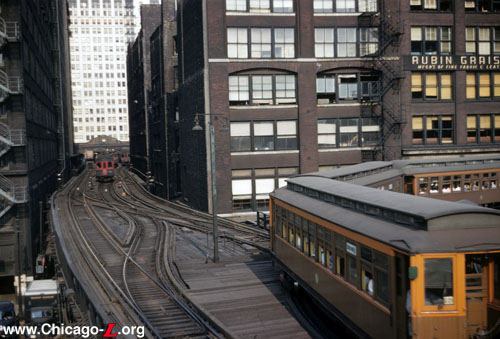
Market Junction and the Wells Street Terminal approach trackage are seen looking east from Market Tower in September 1953. CTA car 2925, an ex-Met wood car, leads a westbound Garfield train coming off the Market Street Loop connector trackage onto the Met main line. A westbound CA&E train is coming through the throat of the terminal and is lined to take the outer track (the left-most track in the foreground); this is last month in which the CA&E operated to/from downtown Chicago via the Garfield Park "L". For
a larger view, click here. (Photo by William C. Janssen, courtesy of the Krambles-Peterson Archive) |

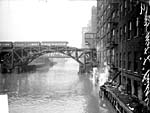
|
n056530.jpg (61k) [Off-site link]
The Metropolitan West Side Elevated's elevated bascule
bridge over the Chicago River -- properly known as the
"Scherzer Rolling Lift Bridge" -- is seen here looking north
on February 4, 1911 from the adjacent Van Buren Street
bridge as a Met elevated train crosses the river. Market Tower, also known as East Bank Tower, is seen peeking out from the building on the right.(DN-0056530, Chicago Daily News negatives collection, Chicago History Museum, courtesy of the Library of Congress) |
Notes:
1. Bronsky, Eric. "The Loop "L" Stub Terminals." First & Fastest. Autumn 1986, p. 25.
2. "The First & Fastest Gallery." First & Fastest. Autumn 1990, p. 12.
3. Bronsky, p. 24
4. "The First & Fastest Gallery," ibid.
5
. Carlson, Norm. "Wells Street Terminal." First & Fastest. Autumn 2003, p. 29.
6. "The First & Fastest Gallery," ibid.
7. Moffat, Bruce G. "The Metropolitan "L" in the 1890s." First & Fastest. Summer 2009, p. MET 8.








